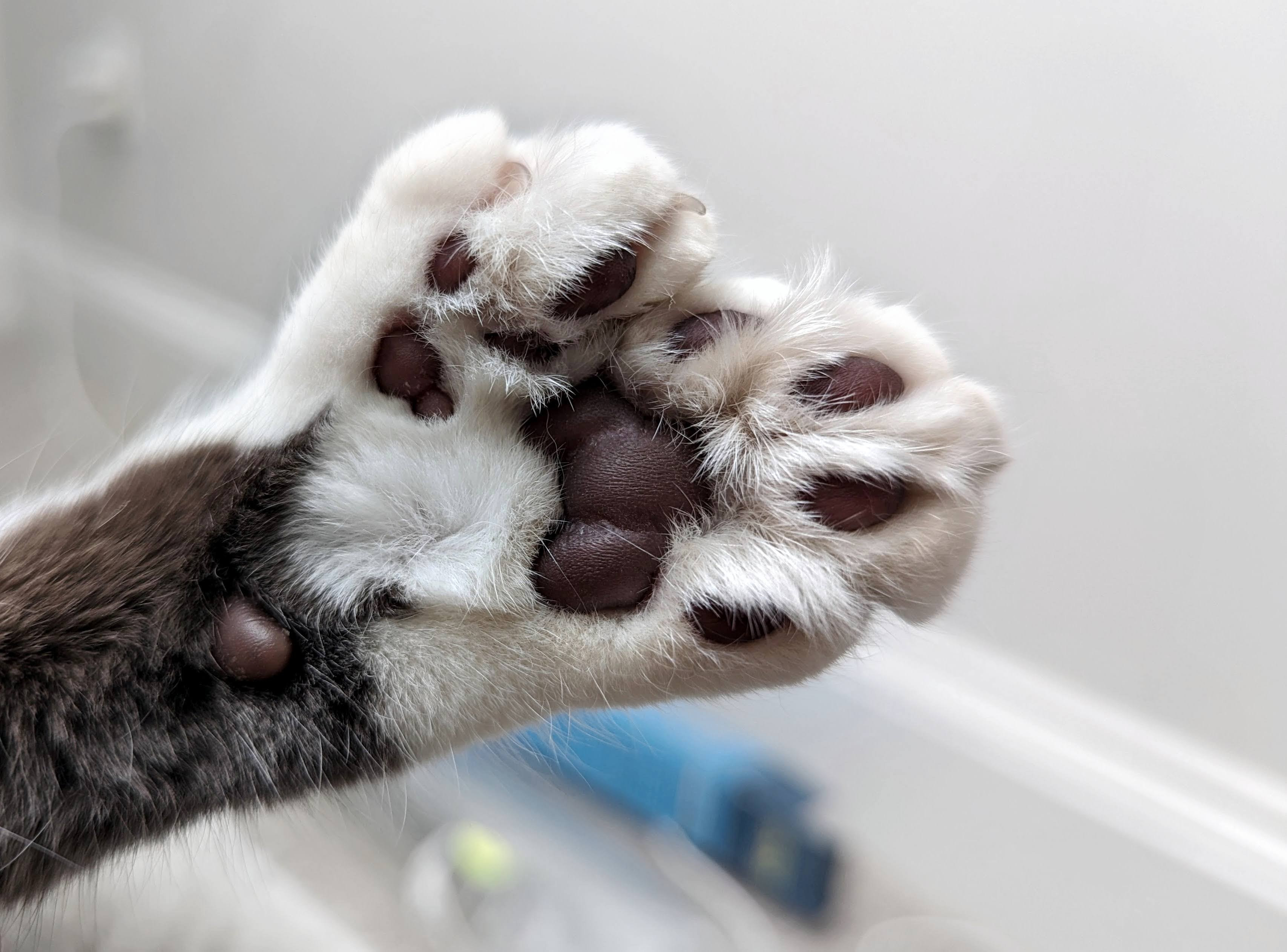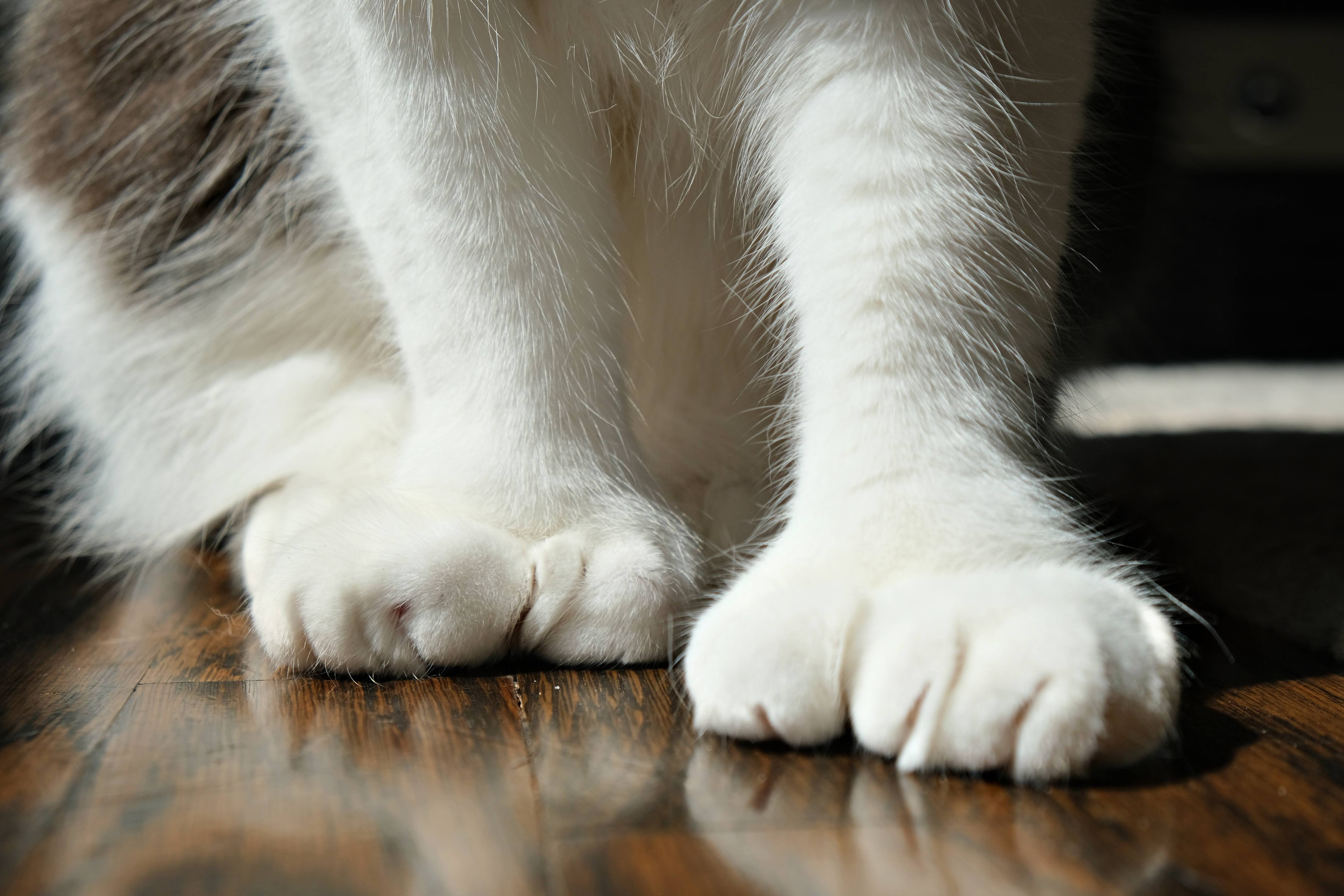If you’ve ever been captivated by the delicate paws of a cat, you’re not alone. Those soft, pillowy pads and retractable claws are undeniably charming. But have you ever wondered about the number of toes a cat has? And perhaps you’ve even noticed some cats seem to have more toes than others? These unique felines are known as polydactyl cats, a term that literally means “many digits.” You might also hear them affectionately called Hemingway cats, mitten cats, or thumb cats, all nodding to their distinctive paws.
So, what exactly causes this adorable anomaly? How many toes should a cat have, and how many can they have? To unravel the mysteries of feline toe counts, we consulted with veterinary experts, Dr. Anita Patel, DVM, a veterinarian and Area Medical Director at IndeVets, and Dr. Alejandro R. Caos, DVM, a small-animal veterinarian at The Vets.
Key Pointers
- Polydactyl cats are defined by having more than the usual 18 toes.
- A polydactyl cat has a 50% chance of passing the polydactyl gene to each kitten if bred with a non-polydactyl cat.
- While most polydactyl cats have just one or two extra toes, some record-holders boast up to 10 additional toes!
Decoding the Standard Cat Paw: 18 Toes
 black and white cat paw with extra toes
black and white cat paw with extra toes
Photo credit: Janelle Leeson
Typically, a cat sports a total of 18 toes. This breaks down to five toes on each front paw and four toes on each back paw. On the front paws, this count includes the dewclaw, which is that little digit positioned higher up the leg, somewhat like a thumb. Interestingly, cats do not naturally have dewclaws on their hind paws.
Dr. Patel clarifies, “Polydactyly is the term we use to describe the presence of extra digits, whether it’s just a single additional toe or an extra dewclaw.” These extra toes can appear on either the front or back paws.
The most common location for these bonus toes is on the inside of the paw, what’s known as the pre-axial or thumb side. Less frequently, extra digits may develop on the outside of the paw (the post-axial or pinky side) or even in the middle (meso-axial). It’s also important to note that these extra toes don’t always appear symmetrically, meaning one paw might have more extra toes than the other.
Just how many toes can a cat have? Prepare to be amazed! An orange tabby cat named Jake holds a record for the most toes on a cat, boasting an incredible seven digits on each paw – that’s a grand total of 28 toes! Sharing this world record title is another polydactyl marvel named Paws, residing in Minnesota, also with 28 toes.
Unpacking Polydactyly: Why Some Cats Have Extra Toes
What’s the secret behind Jake and Paws’ impressive number of toes? Dr. Patel points to genetics as the primary factor.
Polydactylism is categorized as an autosomal dominant trait, albeit with some complexities. In simpler terms, this means that only one parent needs to carry the gene for polydactyly to potentially produce kittens with extra toes in a litter. If a polydactyl cat mates with a non-polydactyl cat, each kitten has a 50% chance of inheriting the polydactyl gene and thus, the extra toes.
The exact reasons why some polydactyl cats develop only a single extra toe while others have many remain somewhat unclear. Dr. Caos explains, “The genetic basis of polydactylism is complex.” It’s an autosomal dominant trait that exhibits what geneticists call incomplete penetrance and variable expression. This intricate genetic dance is what leads to the diverse range of toe configurations seen in polydactyl cats.
The historical origins of polydactyly in cats are also shrouded in some mystery. However, a popular theory suggests that early settlers and sailors might have inadvertently brought polydactyl cats to the Americas. The reasoning? Larger paws could have made these cats particularly adept rodent hunters on ships and in port towns.
While it’s tempting to think of extra toes as providing evolutionary advantages like improved balance, grip, or hunting skills, Dr. Caos clarifies that this might not be the case. He believes that polydactyly in cats is more likely a result of random genetic mutation rather than a crucial adaptation for survival. “Polydactylism is not considered a critical adaptation for cats’ survival in the wild,” he states. “Most cats, regardless of their toe count, are perfectly well-suited to thrive in their natural environments.”
Polydactyl Prevalence: Are Mitten Paws Rare?
 white cat paws with thumbs
white cat paws with thumbs
Photo credit: Janelle Leeson
Despite their unique appearance, polydactyl cats are not actually considered rare. Dr. Caos notes, “When a polydactyl cat mates with a non-polydactyl cat, their kittens have a 50% chance of inheriting the polydactyl gene.” He further adds, “If both parent cats are polydactyl, the probability of their offspring also being polydactyl increases significantly.”
The most commonly observed form of polydactylism in cats involves just one or two extra toes, usually on the front paws. These extra toes often give the paws a “mitten-like” appearance, or even resemble thumbs. Cats with a significantly higher number of extra toes, like the record-holding Jake and Paws, are considered more unusual within the polydactyl cat population.
Breed Predisposition: Which Cats Are More Likely to Be Polydactyl?
While any cat can be born with extra toes, some breeds are more predisposed to polydactyly. Dr. Caos points out that the Maine Coon and Pixie-bob breeds are more frequently associated with extra toes compared to other cat breeds. “Maine Coon cats are known for their substantial size and characteristic tufted ears, and the presence of extra toes further contributes to their distinctive look,” he explains. However, it’s crucial to remember that polydactyly is ultimately determined by a cat’s individual genetic makeup and gene expression, not solely by breed.
You may have also encountered the term “American Polydactyl.” It’s important to understand that this isn’t a recognized breed in itself. Instead, “American Polydactyl” typically refers to cats descended from a population of polydactyl cats that originated in Key West, Florida. The most famous connection to these cats is through the renowned author Ernest Hemingway, a former Key West resident. Hemingway famously owned a six-toed cat named Snow White. Snow White and her descendants thrived at Hemingway’s Key West home, and today, Hemingway’s estate is famously home to over 60 polydactyl cats, often affectionately called “Hemingway cats.”
Caring for Polydactyl Paws: Special Considerations?
Generally, caring for a polydactyl cat is very similar to caring for a cat with the standard 18 toes. However, a few specific aspects deserve a little extra attention:
Nail Maintenance
Due to their increased number of nails, including some that might not regularly make contact with the ground, polydactyl cats are at a higher risk of nail overgrowth. Overgrown nails can lead to discomfort, potential infections, and can easily get snagged on carpets or furniture. Consistent, regular nail trimming is crucial to prevent these issues and keep your polydactyl cat comfortable.
Paw Cleanliness
Dr. Caos highlights, “Extra toes in polydactyl cats can create additional spaces between the toes where dirt, debris, or even litter can accumulate.” Regular inspection of your cat’s paws is recommended. Wiping their paws clean as needed will help prevent buildup and maintain good paw hygiene.
Monitoring Mobility
In most cases, polydactyl cats experience no mobility problems due to their extra toes. However, if your cat has particularly large or unusually formed extra toes, it’s wise to keep an eye on their movement. They should be able to walk, run, and jump comfortably and without any signs of pain.
Dr. Caos advises, “If you observe any limping, favoring of certain paws, or any changes in their usual mobility, it’s best to consult with a veterinarian for a thorough evaluation.” In rare instances where extra toes are causing significant problems, surgical removal might be considered as an option.
In conclusion, polydactyl cats, with their charming extra toes, are a delightful example of natural genetic variation. While they may have a few unique care needs, particularly regarding nail maintenance and paw hygiene, they are generally healthy and happy felines who bring extra joy to the lives of their human companions.
WRITTEN BY
Janelle Leeson
Freelance Writer
